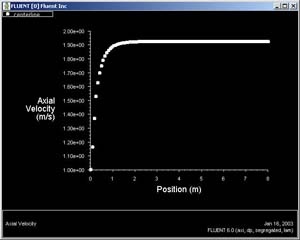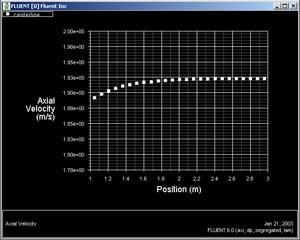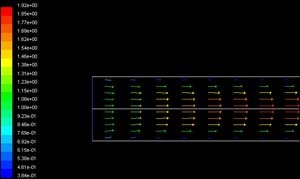...
This brings up a plot of the axial velocity as a function of the distance along the centerline of the pipe.
In the graph that comes up, we can see that the velocity reaches a constant value beyond a certain distance from the inlet. This is the fully-developed flow region.
...
Go back to the Solution XY Plot menu and click Plot to replot the graph with the new axes extents. We can see that the fully-developed region starts at around x=3m and the centerline velocity in this region is 1.93 m/s.
Saving the Plot
Save the data from this plot:
...
Click Apply, Close, and then Plot in the Solution XY Plot Window.
We can see that the fully developed region is reached at around x=3.0m and the skin friction coefficient in this region is around 1.54. Compare the numerical value of 1.54 with the theoretical, fully-developed value of 0.16.
...
Uncheck Write to File under Options so that we can see the graph. Click Plot.
Does this look like a parabolic profile?
...
Now we can plot the velocity profiles at x=0.6m (x/D=3) and x=0.12m (x/D=6) along with the outlet profile. In the Solution XY plot menu, use the same settings as above. Under Surfaces, in addition to outlet, select line1 and line2. Make sure Node Values is selected under Options. Click Plot. Your symbols might be different from the ones below. You can change the symbols and line styles under the Curves... button. Click on Help in the Curves menu if you have problems figuring out how to change these settings.
The profile three diameters downstream is fairly close to the fully-developed profile at the outlet. If you redo this plot using the fine grid results in the next step, you'll see that this is not actually the case. The coarse grid used here doesn't capture the boundary layer development properly and underpredicts the development length.
...
Under Mirror Planes, only the axis surface is listed since that is the only symmetry boundary in the present case. Select axis and click Apply. Close the Views window.
The velocity vectors provide a picture of how the flow develops downstream of the inlet. As the boundary layer grows, the flow near the wall is retarded by viscous friction. Note the sloping arrows in the near wall region close to the inlet. This indicates that the slowing of the flow in the near-wall region results in an injection of fluid into the region away from the wall to satisfy mass conservation. Thus, the velocity outside the boundary layer increases.
...
 Sign-up for free online course on ANSYS simulations!
Sign-up for free online course on ANSYS simulations!




